Electricity and Circuits – 6th Class NCERT CBSE Science Chapter 12
Question: Draw a circuit diagram showing a bulb connected with a cell.
Answer:
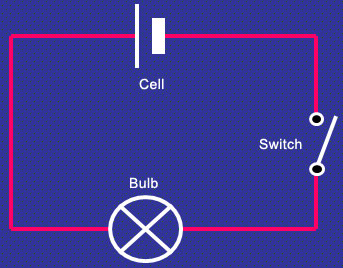
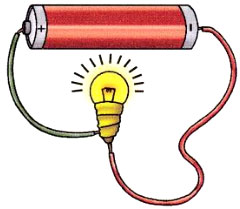
Question: What is an electric circuit?
Answer: The classed path around which an electric current flows is known as electric circuit.
Electricity and Circuits – Question: Why is an electric cell needed in an electric circuit?
Answer: An electric cell is needed in an electric circuit to act as a source in the circuit.
Question: What is the function of the switch in an electric circuit?
Answer: The function of the switch in an electric circuit is to switch on and of the circuit as and when required.
Question: Differentiate between insulators and conductors. Give three examples of each. One of them being a liquid.
Answer:
Conductors:
- The substance that conducts electricity and allows current to flow through.
- For e.g.: Metals like copper and aluminium, sea water.
Insulators:
- The substance that does not bulb electric current to flow through.
- For e.g.: Rubber, plastic, distilled water.
Question: As a safety measure, you are advised to wear rubber skippers or shoes when handling electrical appliances.
Answer: It is said so because if we are not wearing rubber slippers then we may get an electric shock as electric current will pass from head to toe, we will be a part of electric current. If we are wearing the rubber slipper the electric current will stop near the rubber slippers the rubber slippers.
Question: With the help of a well labeled diagram, explain the working of a bulb.
Answer: A bulb has a thin filament which is a very thin metal wire. The filament heats up when an electric current is passed through it by the terminals. It heats up so much that it begins to glow and give out light. Argon is filled in the bulb so that the glass does not react
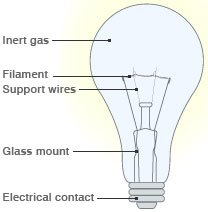
Electricity and Circuits – Question: What are secondary cells?
Answer: Secondary cells are cells that can be recharged if it used up. For e.g. – solar cells.
Question: How will you find out given thing is a good conductor of electricity or not?
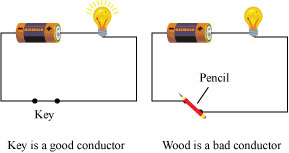
Answer: Lets us take a cell, bulb wires and a safety pin and make simple circuit. Connect the cell with a bulb and leave a arm open and insert the safety pin. If the bulb glows the thing is a good conductor if not it is a bad conductor.
Question: Name one material used to make the negative terminal of a dry cell.
Answer: Zinc is used to make the negative terminal of a dry cell.
Question: With the help of a labelled diagram, explain a dry cell.
Answer: A dry cell is a very convenient source of electric current. The dry cell as its name suggests contain dry or semi-solid ingredients. The dry cell contains a paste of ammonium chloride inside a zinc container. Inside the paste a carbon is placed. The cardboard has microscopic holes in it through which a chemical reaction takes place between ammonium chloride paste and powered manganese dioxide. A road usually carbon with a metal cap is dipped into the manganese dioxide. The whole thing is sealed so that the contents do not split out. The zinccan is also wrapped so that the only base is exposed.
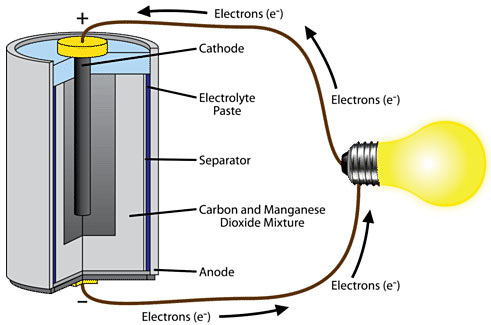
Question: What is the purpose of using an electric switch? Name some electrical gadgets that have switches built into them.
Answer: Electric switch is used to make electric circuit open or closed for a particular appliance and hence with the help of a switch we can use an appliance according
Question: Would the bulb glow after completing the circuit shown in Fig. 12.9 if instead of safety pin we use an eraser?
Answer: No, since eraser is an insulator so it does not allow the current to pass. Hence the bulb will not glow.
Question: Using the“conduction tester” on an object it was found that the bulb begins to glow. Is that object a conductor or an insulator? Explain.
Answer: Yes, if the object is good conductor of electricity then current will pass through conduction tester and the bulb will glow. Hence the object will be a conductor of electricity.
Question: Why should an electrician use rubber gloves while repairing an electric switch at your home? Explain.
Answer: Our body is good conductor of electricity and rubber is insulator. During repairing work if the body comes in contact with current carrying wire then there will not be any accident as rubber does not allow the passage of current through it. Hence electrician uses rubber gloves while repairing an electric switch.
Question: The handles of the tools like screwdrivers and pliers used by electricians for repair work usually have plastic or rubber covers on them. Can you explain why?
Answer: Plastic or rubber is an insulator which does not allow electric current to pass through it. The handles of the tools like screwdrivers and pliers used by electricians for repair have covering of plastic or rubber so that electric current may not pass through these tools to the body of the electrician to harm him.
Question: What is the direction of flow of current in a dry cell?
Answer: The current flows in closed circuit from +ve to -ve terminal of cell.
Question: Name the +ve terminal of dry cell.
Answer: Carbon rod with a metal cap on it.
Question: Name the -ve terminal of a dry cell.
Answer: Zinc metal plate.
Question: What is dry cell?
Answer: It is a device which converts chemical energy into electrical energy.
Question: What is solar cell?
Answer: A device which converts solar energy into electrical energy.
Question: What is open circuit?
Answer: An electric circuit in which electrical contact at any point is broken is called open circuit.
Electricity and Circuits – Question: Write one use of insulators.
Answer: Insulators are used in making switchboard, handles of testers, screw drivers.
Question: What is the name of thin wire in the electric bulb?
Answer: Filament.
Electricity and Circuits – Question: Mention two advantages of a dry cell.
Answer:
- It converts chemical energy into electrical energy.
- It is light and small in size.
Question: Define conductors and insulators. Give one example of each.
Answer:
- A conductor is that which easily allows the passage of current through it. Example: Aluminium or any metal.
- An insulator is that which does not allow the passage of current through it. Example: Rubber.
Question: Identify conductors and insulators from the following:Eraser, paper, matchstick, copper wire, pencil lead, polythene
Answer:
- Conductors: Copper wire, pencil lead.
- Insulator: Eraser, paper, matchstick, polythene.
Question: Name the scientist who invented electric cell and the scientist who invented electric bulb.
Answer:
- Electric cell: Alessandro Volta.
- Electric bulb: Thomas Alva Edison.
Question: Give one activity to prove that air is an insulator.
Answer: Take an electric circuit, keep the terminals unconnected in the air. The bulb do not glow, as air is an insulator and does not allow the current to flow through it.
Question: In any electric circuit, when the switch is on and the current flows through it why do the wire, switches, bulb or devices become hot?
Answer: This is because electric energy changes into heat energy.
Question: The headlights of a car have reflectors behind the bulb. What is the function of reflectors?
Answer: The reflector helps in reflecting the light into a focused area.
Question: If you touch an electric wire carrying current you get a shock, but if on the same wire the birds sit they do not get any shock / current. Explain why?
Answer: When we hold the wire carrying current then the circuit is closed and the current flows from our body and enters earth but the birds sitting on the same wire do not get any current as the circuit is not complete. If the bird touches the earth wire, it will also die due to electric shock.
Electricity and Circuits – Question:
- What is electric circuit?
- How many types of electric circuit are there? Define them.
- Draw a diagram to show the closed circuit for switch, bulb and dry cell.
Answer:
(1) The diagram that shows the path of electric current is called electric circuit.
(2) There are two types of electric circuit:
- Open electric circuit: The circuit in which electrical contact at any point is broken is called open electric circuit.
- Closed electric circuit: The circuit in which electric current flows from one terminal of a cell or battery to the other is called a closed circuit.

Question: What is the purpose of using an electric switch? Name some electrical gadgets that have switches built into them.
Answer: A switch is an electric device that is used to complete or break an electric circuit. If the switch is ‘ON’, then a current can flow through the circuit. However, if the switch is ‘OFF’, then the current cannot flow through the circuit. Electrical appliances such as table fans, electric lamps, washing machines, juicers and mixers, TV, radio, etc. have switches built into them.
Question: Using the ‘conduction tester’ on an object, it was found that the bulb begins to glow. Is the object a conductor or an insulator? Explain.
Answer: When the two free ends of a conductor tester are touched with an object, then the bulb of the tester would glow if the object conducts electricity. However, the bulb would not glow if the object does not conduct electricity. Since the bulb glows when the tester is touched with the object, the object must conduct electricity. Hence, the object is a conductor.
Electricity and Circuits – Question: Why should an electrician use rubber gloves while repairing an electric switch at your home? Explain.
Answer: An electric switch is an electrical appliance. It conducts electricity through its internal parts. When its internal parts are touched with naked hands, then it may cause an electric shock. Therefore, it should be touched with rubber gloves in hand because rubber cannot conduct electricity. Hence, electricians wear rubber gloves while repairing a switch or any other electrical appliance.
Question: Handles of tools such as screwdrivers and pliers used by electricians for repair work usually have plastic or rubber cover on them. Can you explain why?
Answer: Rubber is a bad conductor of electricity. It does not allow current to flow through it. Hence, handles of tools such as screwdrivers, pliers, etc. which are used by electricians for repair work usually have plastic or rubber cover on them. This protects them from electric shocks.
 Class Notes NCERT Solutions for CBSE Students
Class Notes NCERT Solutions for CBSE Students


